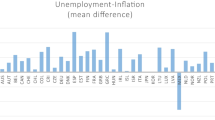Summary
The Base Money Stock - A New Indicator of Monetary Policy. - This paper analyzes the indicator properties of alternative base money concepts used by the German Council of Economic Experts and by the Deutsche Bundesbank. Both concepts are flawed by an inadequate treatment of changes in legal reserve requirements. As a result, the direct contribution of monetary policy to money growth has been continuously understated by the Council’s indicator, during recent years, while the Bundesbank’s central bank money stock has moved between understating (1983, 1984) and overstating (1982, 1985) the policy contribution. Finally, a superior base money measure is proposed which combines the source base with a multiplier based on a logarithmic reserve adjustment.
Résumé
La masse monétaire debase - un nouvel indicateur de la politique monétaire. — Dans cet article l’auteur analyse les propriétés d’indicateur des approches alternatives de la monnaie de base utilisées par le Conseil Allemand des Experts Economiques et par la Banque Centrale de la RFA. Les deux approches sont préjudiciées par le traitement inadéquat des changements en réserves de caisse obligatoires. Comme résultat, l’indicateur du Conseil a continûment sous-estimé la contribution directe de la politique monétaire à l’expansion de la masse monétaire dans des années récentes, pendant que le stock de monnaie de la banque centrale utilisé par la Banque Centrale a fluctué entre une sous-estimation (1983, 1984) et une sur-estimation (1982, 1985). Enfin, l’auteur propose une mesure supérieure de la monnaie de base qui combine la base de source avec un multiplicateur basé sur un ajustement de réserve logarithmique.
Resumen
La base monetaria: un nuevo indicador par la polftica monetaria. - En este trabajo se analizan las propiedades de distintos conceptos de base monetaria utilizados por el Consejo Alemán de Asesores Económicos y por el Banco Central Alemán. La debilidad de ambos conceptos consiste en que no logran tratar adecuadamente a los cambios del encaje legal. Por esta razón, la contributión directa de la política monetaria al crecimiento de la oferta monetaria ha sido continuamente subestimada por el indicador utilizado por el Consejo en los años recientes, mientras que el indicador utilizado por el Banco Central ha estado subestimando (1983, 1984) y sobreestimando (1982, 1985) el aporte de esta política. Finalmente, se propone un indicador de la base monetaria que combina la base con un multiplicador con ajuste logarítmico del encaje.
Similar content being viewed by others
Literatur
Brunner, Karl, “A Schema for the Supply Theory of Money”.International Economic Review, Vol. 2, 1961, S. 79–109.
—, “Analyse monetÄrer Hypothesen des SachverstÄndigenrats zur Begutachtung der gesamtwirtschaftlichen Entwicklung”.Kyklos, Vol. 24, 1971, S. 223–238.
—, —, “MonetÄre Aspekte des Jahresgutachtens 1971/72 des SachverstÄndigenrats”.Weltwirtschaftliches Archiv, Vol. 108, 1972, S. 257–285.
Burger, Albert E., Robert H. Rasche, “Revision of the Monetary Base”.Federal Reserve Bank of St. Louis Review, Vol. 59, 1977, Nr. 7, S. 13–28.
Courakis, Anthony S., ⋯On Unicorns and Other Such Creatures: The Case of the German Central Bank Money Stock”.Zeitschrift für die Gesamte Staatswissenschaft, Vol. 136, 1980, S. 28–49.
Deutsche Bundesbank, ⋯Zentralbankgeldmenge und freie LiquiditÄtsreserven der Banken”.Monatsberichte, Vol.26, 1974, Nr. 7, S. 14–23.
—,Geldpolitische Aufgaben und Instrumente. Sonderdrucke der Deutschen Bundesbank Nr. 7, 2. Aufl. Frankfurt 1983.
—, “Zur lÄngerfristigen Entwicklung und Kontrolle des Geldvolumens.”Monatsberichte, Vol. 37, 1985, Nr. 1, S. 14–28.
Duwendag, Dieter, “Die neue Geldpolitik der Deutschen Bundesbank: Interpretation und kritische Anmerkungen.”Konjunkturpolitik, Vol. 22, 1976, S. 265–306.
Frost, Peter A., “Short-Run Fluctuations in the Money Multiplier and Monetary Control”.Journal of Money, Credit and Banking, Vol. 9, 1977, S. 165–181.
Kath, Dietmar, “Das monetÄre Interpretations- und Steuerungskonzept der Deutschen Bundesbank”.Wirtschaftswissenschaftliches Studium, Vol. 5, 1976, S. 356–362.
Neumann, Manfred J. M., “Konstrukte der Zentralbankgeldmenge”.Kredit und Kapital, Vol. 8, 1975, S. 317–345.
—, “Indicator Properties of the St. Louis Monetary Base”.Journal of Monetary Economics, Vol. 12, 1983, S. 595–603.
-,Jürgen von Hagen, ⋯Theoretische und empirische Grundlagen von Geldmengenzielen und ihrer Realisierung”. In: Armin Gutowski (Hrsg.),Geldpolitische Regelbindung: Theoretische Entwicklungen und empirische Befunde. Berlin 1986.
SachverstÄndigenrat zur Begutachtung der gesamtwirtschaftlichen Entwicklung,Mut zur Stabilisierung. Jahresgutachten 1973/74, Stuttgart 1973.
-, ⋯Methodischer Anhang”.Jahresgutachten, versch. Jgg.
Schulz, Harald, “Zur AussagefÄhigkeit der Zentralbankgeldmenge als Indikator im geldpolitischen Konzept der Deutschen Bundesbank”.Kredit und Kapital, Vol. 13, 1980, S. 263–276.
About this article
Cite this article
Neumann, M.J.M. Die Grundgeldmenge — Ein neuer Indikator der Geldpolitik. Weltwirtschaftliches Archiv 122, 520–532 (1986). https://doi.org/10.1007/BF02707377
Published:
Issue Date:
DOI: https://doi.org/10.1007/BF02707377




